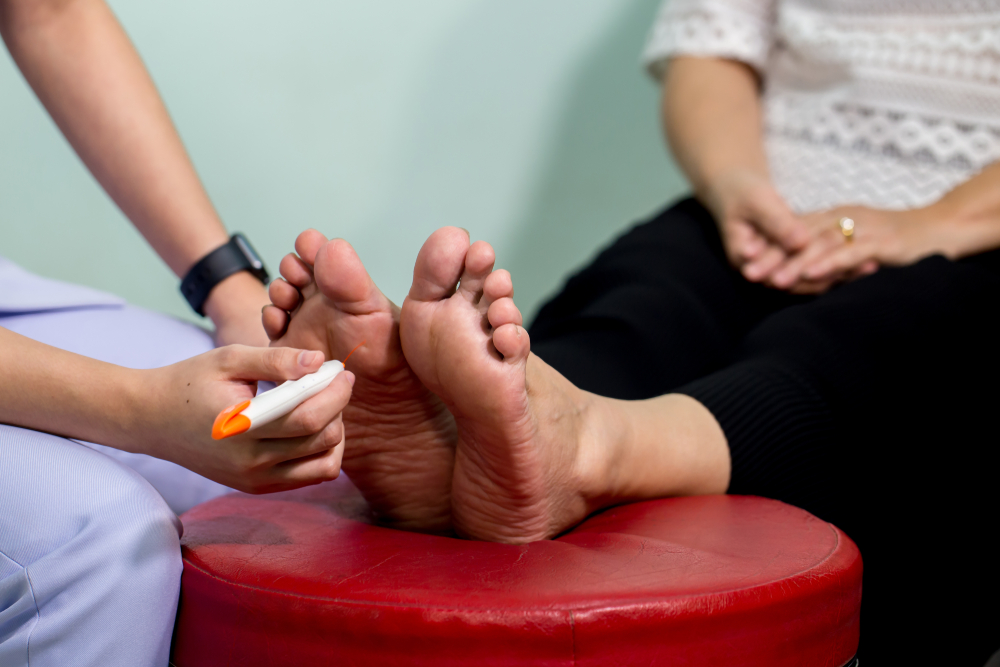Diabetic neuropathy, or nerve damage, is one of the most common and serious complications of diabetes. Cases of diabetic neuropathy in Asia are high. A Diabcare‐Asia study of 22,177 patients in 230 diabetes centres located in 12 Asian regions showed a prevalence of 29% in type 1 diabetes and 35% in type 2 diabetes.
Here’s a look at how this particular nerve damage can affect your body, specifically your feet if you are suffering from diabetes.
Your Feet and Diabetic Neuropathy
People with diabetic neuropathy are often left unaware of the nerve damage until it is discovered during a routine doctor’s check-up. Diabetic neuropathy is classified into four types, the most common of which is called peripheral neuropathy. The other three are autonomic neuropathy, proximal neuropathy and mononeuropathy.
Peripheral nerve damage, in particular, refers to the damaged nerves that are located outside the brain and spinal cord. This type of neuropathy in people with diabetes normally affects the feet and legs, causing a burning sensation, discomfort, numbness and pain in the lower limbs. Oftentimes, the symptoms initially manifest themselves in either one foot or both feet before it spreads to your arms and hands.
One-third to one-half of diabetics are predisposed to peripheral neuropathy, triggered by their high levels of blood glucose and lipids. It also remains to be a highly misdiagnosed or underdiagnosed condition, particularly in Southeast Asia and the Middle East.
There are cases in those diabetics with peripheral neuropathy are unaware of an injury or sore on their foot. Worse, their wounds typically take longer to heal because of their poor blood circulation brought about by their high blood sugar levels. When this happens, their risk of infection increases and, if the condition is checked too late or the damage cannot be reversed anymore, the doctor may not have any other recourse but to do amputation to prevent the infection from further spreading.
As the feet are among the most common to be affected by diabetic neuropathy, individuals with this condition may experience mobility difficulties such as walking and climbing stairs. Other foot health issues may also arise, including ulcers, bone and joint pain, bunions and hammer toes.
What are the Warning Signs?
The four types of diabetic neuropathy have different symptoms. When you have peripheral neuropathy, you may experience numbness, pain and a burning and tingling sensation.
Other symptoms of peripheral neuropathy include:
- Muscle weakness
- Lack of balance or coordination
- Increased sensitivity to touch or painful stimuli
- Dizziness when standing up
- Bladder problems
- Double vision
- Tingling in the soles
It has been reported that the symptoms are at their worse during nighttime.
Diagnosis and Treatment
The American Diabetes Association (ADA) recommends that those with type 2 diabetes should be immediately screened for diabetic neuropathy. People with type 1 diabetes may do so five years after their diagnosis. Annual screening, which includes a physical exam, sensitivity level test, and muscle tone, blood pressure and heart rate tests, should follow thereafter.
To date, there is no specific cure for diabetic neuropathy, but a lifestyle change, regular medical screenings and blood sugar monitoring may do the trick in helping slow down its progress and ease some of its symptoms. Your doctor may also recommend pain medication, complementary treatments or alternative therapies such as acupuncture to help manage the nerve damage.
Talk to your doctor today to know the most appropriate treatment method for you.
Conclusion
Diabetics are at high risk of developing nerve damage. As a common complication amongst diabetics, peripheral neuropathy, in particular, can result in grave foot problems. If you have peripheral neuropathy or feel that you are susceptible to this condition, you must pay special attention to your feet. Don’t hesitate to consult your doctor if you see an injury or sore on your foot. With proper foot care and regular consultation with your doctor, you may avoid diabetic neuropathy or at the very least delay its progress.
References
- https://www.researchgate.net/publication/340525417_Diagnosing_Peripheral_Neuropathy_in_South_East_Asia_A_Focus_on_Diabetic_Neuropathy
- https://www.ncbi.nlm.nih.gov/pmc/articles/PMC7477502/#:~:text=In%20a%20study%20of%20134,Disability%20Score%20was%2050.7%25%2024%20.
- https://www.betterhealth.vic.gov.au/health/conditionsandtreatments/diabetic-neuropathy
- https://www.healthline.com/health/type-2-diabetes/diabetic-neuropathy#symptoms
- https://www.cdc.gov/diabetes/library/features/diabetes-nerve-damage.html
- https://www.cdc.gov/diabetes/library/features/diabetes-nerve-damage.html












